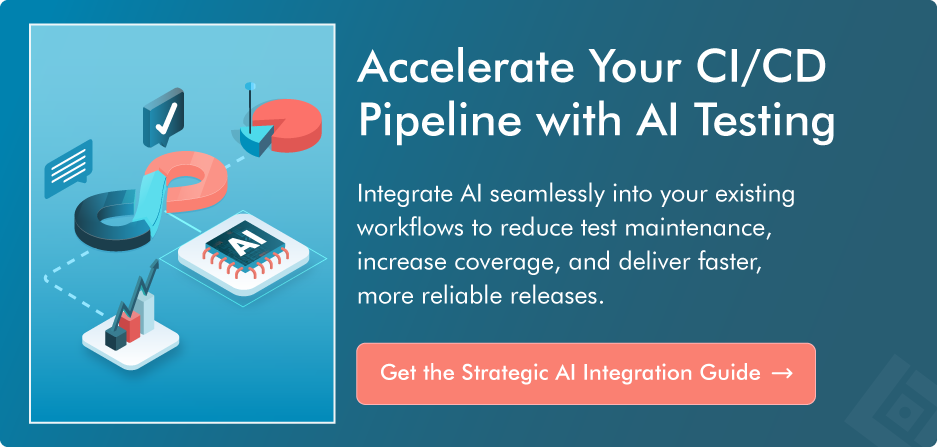
Integrating AI testing into your CI/CD pipeline is a strategic approach that improves test efficiency, reduces maintenance effort, and accelerates release cycles. AI can complement your existing tools by adding intelligent capabilities such as dynamic test selection, self-healing automation, and predictive defect detection.
-
Role of AI in Modern CI/CD Workflows
Traditional CI/CD pipelines often rely on scripted, deterministic test execution. These pipelines lack adaptability when faced with complex systems or rapid code changes. AI complements your existing setup by introducing:
-
Intelligent test selection based on code changes
-
Self-healing automation scripts that adapt to UI changes
-
Failure prediction and root cause analysis
-
Anomaly detection in deployment and runtime behavior
-
-
Connecting AI Testing to Your CI/CD Stages
-
Source Code Repositories (Git, GitHub, GitLab, Bitbucket): AI tools can hook into your version control system to analyze commits, pull requests, and branches. This enables:
-
Risk-based testing recommendations
-
Change impact analysis
-
Mapping code changes to specific test cases
Integration Mechanism: Webhooks, Git APIs, and CI triggers.
-
-
CI Servers (Jenkins, GitLab CI, CircleCI, Bamboo): CI servers are where build and test workflows are orchestrated. AI testing solutions can be integrated with:
-
Run optimized test suites post-build
-
Use ML models to predict which tests are redundant or high-priority
-
Detect flaky tests and suppress false positives
Integration Mechanism: Plugin or shell script execution inside CI job configurations.
-
-
Test Automation Frameworks (Selenium, Cypress, Appium): AI enhances test automation frameworks by making them more maintainable and adaptive. It can:
-
Automatically update locators in UI test scripts
-
Detect and fix brittle tests
-
Suggest new test cases based on user behavior
Integration Mechanism: Wrappers around existing frameworks, SDKs, and custom AI libraries.
-
-
Test Management Tools (TestRail, Zephyr, QMetry): These tools hold test artifacts, cases, and execution history. AI solutions can tap into them to:
-
Identify outdated or redundant tests
-
Suggest new cases based on test gaps
-
Automatically classify test failures
Integration mechanism: RESTful APIs and direct database queries.
-
-
Monitoring and Observability Platforms (New Relic, Datadog, Prometheus): AI testing tools can consume production logs and metrics to detect:
-
Behavior deviations after release
-
Slowdowns, exceptions, and regressions
-
Non-deterministic issues missed during QA
Integration Mechanism: Log streaming services, ingestion pipelines, or direct integration with observability platforms.
-
-
Key Advantages of Integrating AI into Your Pipeline
- AI reduces test execution time by selecting only the most relevant test cases based on recent code changes, eliminating the need to run complete regression suites every time.
- It minimizes test maintenance by using self-healing capabilities that automatically detect and fix broken UI locators and script elements.
- AI enhances overall test coverage by identifying previously untested application areas and generating test cases to address these gaps.
- It reduces the risk of production failures by utilizing historical data and behavioral analysis to identify code weaknesses before deployment.
- AI enables earlier bug detection through static and dynamic code analysis, allowing development teams to resolve issues before they escalate in later stages of the pipeline.
Integration Example: Jenkins + Selenium + AI
Let’s say your current setup includes Jenkins for CI and Selenium for test automation. Here's how AI plugs in:
- After every commit, Jenkins triggers the build
- AI hooks into the job and runs change-impact analysis on the latest commit
- It selects the minimal set of Selenium tests required to validate the change
- During execution, AI self-heals any failing locators
- Post-test, AI analyzes failure logs and predicts whether it's a genuine issue or flakiness
- Jenkins publishes the final result and notifies relevant team members
A Step-by-Step Look at AI Testing Integration with DevOps Pipelines
- Begin by assessing whether your existing CI/CD tools and test frameworks support integration through APIs, plugins, or scripting interfaces.
- Select a small, manageable module or workflow to introduce AI-based testing, enabling you to monitor results without affecting the entire system.
- Train your AI model using historical test results, production logs, and defect data to help it make accurate predictions and recommendations.
- Establish a human-in-the-loop process where QA engineers review and validate the AI’s decisions during the initial phase to ensure quality and trust.
- Once the AI solution demonstrates consistent performance, incrementally expand its use across additional projects, environments, and testing layers.
Conclusion
AI testing solutions integrate seamlessly with existing CI/CD pipelines through APIs, plugins, and automation hooks, facilitating a smooth integration. By starting with a small scope and expanding based on results, teams can integrate AI into their workflows with minimal disruption and a measurable impact.


Post a Comment